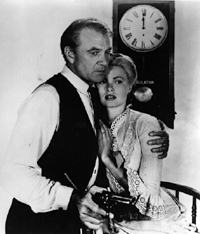

USA drama
1952
bw 83 min.
Director: Fred Zinnemann
CLV: $49.95 - available
1 disc, catalog # CC1173L

It has been estimated that one out of four feature films made in
America before the mid-1960s was a western. Since approximately 35,000
features were released in this country in the 70 years after the
introduction of film, this would mean that over 5,000 westerns have
been projected in America's movie theaters, making it the largest
genre in film history.
In spite of their prolific numbers, few westerns have won major
awards, were among the top grossing films of the year, or came to be
included in lists of the best American films compiled by critics,
historians, or audiences. High Noon is the rare exception.
High Noon was one of the top ten money-makers of 1952, was
named "Best Motion Picture" of the year by most of the periodicals and
institutions that gave such awards at the time, and was nominated for
an Academy Award as Best Picture. In addition, each of its four
principal creative contributors -- its star, Gary Cooper, its
director, Fred Zinnemann, its writer, Carl Foreman, and its composer,
Dimitri Tiomkin, were nominated for individual Academy Awards. In the
years since its original release, High Noon has been singled
out for discussion in virtually every history of American film.
But High Noon has also been controversial, for several
reasons. Four of the people involved in its making were swept up in
the hearings of the House Committee on Un-American Activities while
the film was being readied for release, and there has been ongoing
debate over the extent to which the film was intended to be a parable
on Hollywood's cowardice during those days -- or of the entire
phenomenon that has gone down in history as "The McCarthy Period."
High Noon's haunting -- some would say incessant -- theme
song has also been controversial. "Do Not Forsake Me, Oh My Darlin' "
was composed by Dimitri Tiomkin, with lyrics by Ned Washington and
sung by Tex Ritter. It demonstrated that a song can significantly
heighten a film's emotional power, help tell its story, and also
dramatically increase the film's profit potential, both by helping to
advertise the film itself and through recording royalties. Tiomkin
received two different Academy Awards for his creation.
The photography of High Noon has also been controversial,
and its cinematographer, Floyd Crosby, was almost fired for what this
bosses saw as "incompetent work." Actually, Crosby and Fred Zinnemann
had carefully studied the look of Matthew Brady's famous Civil War
still photographs, with their lack of filtering and high contrast
between light and dark, and had sought to achieve a similar look on
film. Today, High Noonis studied in film classes as an example
of the power of black-and-white photography.
Gary Cooper, it is strange to recall now, was frequently dismissed
by critics in his own time, who claimed he was merely "playing
himself." However, Lee Strasberg, "The Father of Method Acting,"
pointed out that Cooper was actually one of the first film actors to
use Method Acting on the screen, although his use of this important
tool was based on intuitive understanding. Cooper's performance
inHigh Noon is regarded by many as the finest performance of
his astonishingly long and varied career, and it not only won him an
Academy Award, it placed him at the top of the list of stars at the
box office. His portrayal of the beleaguered but defiant marshall
remains today a classic example of the difference between theatrical
and filmic acting styles, demonstrating how powerful screen
performances depend heavily on reaction rather than action.
Grace Kelly, appearing herein her first important screen role,
hated her own performance, frequently condemning her stiffness in the
role of Amy, the new bride of the marshall forced to choose, like him,
between conscience and love, but the judgment of history is inclined
to see it as one of her most memorable roles.
Finally, there has been controversy over the extent to which the
film's editor, Elmo Williams, "saved" the picture in the cutting
room. But nobody "saved" the picture -- High Noon is one of the
leading examples of the possibilities of film as a collaborative art,
with important contributions from its director, writer, producer,
cinematographer, editor and actors. High Noon is one of the few
American films that follow the classic Aristotelian principle of the
"classic unities" of time, place and action. The running time of the
story almost exactly parallels the running time of the film
itself. This effect is heightened by the frequent use of clocks
throughout the film that remind the characters -- and the audience --
of the imminent arrival of Frank Miller, the villain, on the noon
train.
As suggested in the audio essay on track two, what makes High
Noon one of the most memorable films of all time, what earned it
its place in history, is the fact that High Noon does what all
of the most popular films in history have done: it casts into modern
form some of the oldest mythological structures of the human race. At
the heart ofHigh Noon is its archetypal hero, Will Kane, caught
in a struggle of conscience between duty and desire. It is one of the
oldest and most meaningful of stories, squarely facing its tragic
potential and rising above it to achieve a reaffirmation of the power
of individual human will and courage.
-- HOWARD SUBER
Credits
Producer: Stanley Kramer
Director: Fred Zinnemann
Screenplay: Carl Foreman
Based on the story "The Tin Star" by: John Cunningham
Assistant Director: Emmett Emerson
Cinematographer: Floyd Crosby, A.S.C.
Editorial Supervisor: Harry Gerstad
Production Supervisor: Clem Beauchamp
Production Design: Rudolph Sternad
Art Director: Ben Hayne
Music Composed and Directed by: Dimitri Tiomkin
Film Editor: Elmo Williams, A.C.E.
Sound: Jean Speak
Ballad "High Noon" Composed by Dimitri Tiomkin; lyrics by Ned Washington; sung by Tex Ritter
Transfer
This edition of High Noon was transferred from the best
available 35mm negative.





